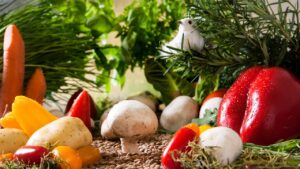Ready to take your vegetable garden to the next level? Look no further than the power of the right fertilizer. In this article, we’ll show you how to boost the growth of your vegetable garden by choosing the best fertilizer. Whether you’re a seasoned gardener or just starting, we have all the tips and tricks to help you achieve a bountiful harvest. From understanding the NPK ratio to choosing organic options, we’ve got you covered. Get ready to watch your veggies thrive and taste better than ever before!
Importance of Fertilizer in Vegetable Gardening
One critical factor in vegetable gardening’s success and bountiful harvest is fertilizer use. Fertilizers supply essential nutrients to plants, enhance their development, and increase productivity. By understanding the nutritional needs of vegetables and choosing the right type of fertilizer, you can create an optimal environment for your plants to thrive.
Understanding the Nutritional Needs of Vegetables
To determine the best fertilizer for your vegetable garden, it is essential to understand the nutritional needs of different types of vegetables. Just like humans, plants require a balanced diet to grow and flourish. Vegetables need two main categories of nutrients: macronutrients and micronutrients.
Macronutrients
Macronutrients are nutrients that plants require in large quantities. These include nitrogen, phosphorus, and potassium, commonly called NPK. Nitrogen promotes healthy leaf and stem growth, phosphorus supports root development and flowering, and potassium contributes to plant strength and disease resistance.
Micronutrients
In addition to macronutrients, vegetables also require smaller amounts of micronutrients. These include essential elements such as calcium, magnesium, iron, and zinc. Although micronutrients are needed in smaller quantities, they are equally crucial for proper plant growth and development.
Types of Fertilizers for Vegetable Gardens
Several types of fertilizers are available for vegetable gardens, each with its advantages and applications. Understanding the differences between these types of fertilizers can help you choose the one that best suits your plants’ needs.
Organic Fertilizers
Organic fertilizers are derived from natural materials such as compost, manure, and bone meal. They release nutrients slowly and provide a steady supply of organic matter to the soil. Organic fertilizers improve soil structure, promote microbial activity, and enhance soil health.
Inorganic Fertilizers
Inorganic fertilizers, also known as synthetic or chemical fertilizers, are made from mineral sources. They provide nutrients readily available to plants and are often formulated to deliver specific ratios of NPK. Inorganic fertilizers are commonly used for their quick-release properties and ability to address specific nutrient deficiencies.
Slow-Release Fertilizers
As the name suggests, slow-release fertilizers release nutrients slowly over an extended period. They come in various forms, including coated granules or pellets. Slow-release fertilizers are particularly beneficial for plants with long growing seasons or for gardeners who prefer a low-maintenance approach.
Liquid Fertilizers
Liquid fertilizers are convenient for providing plant nutrients through the foliage or root system. They are available as concentrated solutions that can be diluted with water and applied using a watering can or sprayer. Liquid fertilizers are ideal for quick nutrient boosts or foliar feeding during periods of high plant demand.
Choosing the Right Fertilizer for Your Vegetable Garden
Given the many options available, selecting the right fertilizer for your vegetable garden can be overwhelming. However, a few essential factors to consider will help guide your decision-making process.
Soil Testing
Before adding any fertilizer to your garden, it is crucial to perform a soil test. This test will determine the nutrient levels present in your soil and identify any deficiencies or imbalances. By knowing the current state of your soil, you can make informed decisions about which nutrients to focus on and the appropriate fertilizer to use.
Matching Nutrient Requirements
Different vegetables have varying nutrient requirements. You must match these requirements to the nutrient content of your chosen fertilizer. For example, leafy green vegetables like lettuce and spinach require higher nitrogen levels, while root crops such as carrots and potatoes benefit from phosphorus-rich fertilizers. Matching the nutrient needs of your vegetables ensures they receive the necessary elements for optimal growth.
Considering pH Levels
In addition to nutrient requirements, it is essential to consider the pH level of your soil. The pH level affects the availability of nutrients to plants. Some vegetables prefer acidic soil, while others thrive in alkaline conditions. Conducting a soil test will help determine the pH of your garden, allowing you to choose a fertilizer that can help modify and maintain the pH at the optimal range for your specific vegetables.
Applying Fertilizer at the Right Time
Proper timing of fertilizer application is crucial to maximize its effectiveness and minimize potential harm to plants. Different fertilizer application methods can be employed at various stages of plant growth.
Pre-Planting Fertilization
One common practice is to apply fertilizer before planting. This allows nutrients to be readily available to young seedlings as they establish their root systems. Incorporating organic matter or slow-release fertilizers into the soil before planting can provide a steady supply of nutrients throughout the growing season.
Side-Dressing
Side-dressing refers to applying fertilizer around the base of established plants during the growing season. This provides an additional nutrient boost to support plant growth and production. Nitrogen-rich fertilizers are often side-dressed to leafy vegetables like lettuce and cabbage, promoting vigorous leaf development.
Foliar Feeding
Foliar feeding involves spraying liquid fertilizers directly onto plants’ leaves. This method provides a quick nutrient absorption route, bypassing the root system. Foliar feeding is often utilized when plants show signs of nutrient deficiencies or during critical growth stages. Following the manufacturer’s instructions carefully is essential to prevent leaf burn and ensure proper nutrient uptake.
Proper Techniques for Fertilizer Application
Applying fertilizer using the correct techniques ensures efficient nutrient distribution and minimizes plant waste or potential harm.
Broadcasting
Broadcasting involves spreading fertilizer evenly across the entire gardening area. This method is suitable for extensive vegetable gardens. It is important to follow recommended application rates to avoid over-fertilization or nutrient imbalances. After broadcasting, the fertilizer should be gently incorporated into the soil to prevent nutrient runoff or leaching.
Band Application
Band application involves placing fertilizer in narrow rows or bands near the plant roots. This technique is beneficial for row crops or when targeting specific plants. Plants can access nutrients more efficiently by applying fertilizer close to the root zone. Band application also reduces the risk of fertilizer being wasted or ending up in areas where it is not needed.
Topdressing
Topdressing refers to adding a thin layer of fertilizer on the soil surface around established plants. This method is effective for slow-release fertilizers or when additional nutrients are required throughout the growing season. Avoiding direct contact with the plant stems or foliage is essential to prevent burning.
Fertilizer Incorporation
Incorporating organic fertilizers or slow-release granules into the soil is crucial. This ensures proper diffusion of nutrients and prevents loss due to precipitation or surface runoff. To mix the fertilizer thoroughly, it is recommended to rake lightly or till the soil after application.
Feeding New Seedlings and Transplants
New seedlings and transplants require extra care and attention to establish themselves successfully in the garden. Providing them with a nutrient-rich soil mix and following proper transplanting techniques can give them the best start.
Nutrient-Rich Soil Mix
Before transplanting seedlings or young plants, prepare a well-balanced soil mix that provides a rich source of nutrients. A combination of compost, aged manure, and organic matter can enhance the soil’s fertility and structure. Mixing the soil thoroughly with these amendments will ensure a steady supply of nutrients as the plants grow.
Transplanting Tips
Handle them carefully when transplanting seedlings or young plants to avoid damaging the roots. Please ensure the planting hole is deep enough to accommodate the roots without twisting or crowding them. Gently backfill the hole with the nutrient-rich soil mix, pressing it down to eliminate air pockets. Water thoroughly after transplanting to help the roots establish and avoid transplant shock.
Fertilizing Container Vegetable Gardens
Container vegetable gardens require special attention when it comes to fertilizer application. Unlike plants in the ground, container plants rely solely on the nutrients provided in the potting mixture. Choosing suitable fertilizers, adjusting the frequency of application, and monitoring nutrient levels are crucial for container gardening success.
Choosing Suitable Fertilizers
Selecting fertilizers formulated explicitly for potted plants is essential for container vegetable gardens. These fertilizers are often labeled as “container” or “potting mix” fertilizers and provide the necessary nutrients in a balanced ratio. They usually contain slow-release components to ensure a steady supply of nutrients over time.
Frequency of Application
Container plants often require more frequent fertilization compared to those in the ground. The limited soil volume and increased irrigation can result in the leaching of nutrients. Follow the fertilizer manufacturer’s recommendations for frequency and dosage, but be cautious not to over-fertilize, as this can lead to nutrient imbalances or plant burn.
Monitoring Nutrient Levels
Regularly monitoring the nutrient levels in container gardens is essential to maintain optimal plant health. Visual observation of plant growth, leaf color, and overall vitality can explain nutrient deficiencies or excesses. Conducting periodic soil tests can also help determine if adjustments to the fertilizer regime are necessary.
Common Mistakes to Avoid in Vegetable Garden Fertilization
While proper fertilization is essential for vegetable gardening success, gardeners should avoid several common mistakes to ensure optimum plant health and productivity.
Overfertilizing
One of the most common mistakes is overfertilizing. Applying excessive amounts of fertilizer can lead to nutrient imbalances, burning of plant roots, and leaching of nutrients. Following the recommended application rates and not exceeding the manufacturer’s guidelines is crucial.
Under fertilizing
Conversely, underfertilizing can result in nutrient deficiencies, stunted growth, and reduced yields. Pay attention to the visual signs of nutrient deficiencies, such as yellowing leaves or poor plant vigor. Adjust the fertilization regime accordingly to meet the plant’s nutrient requirements.
Imbalanced Nutrient Ratios
Using fertilizers with imbalanced nutrient ratios can hinder plant growth and development. Choosing fertilizers that provide a balanced blend of macronutrients and micronutrients is essential, ensuring that all the necessary elements are available appropriately.
Using Improper Fertilizer Forms
Using the wrong form of fertilizer can also impact plant health. Ensure that the fertilizer suits the specific gardening conditions and application method. Slow-release fertilizers are ideal for long-term plant nutrition, while liquid fertilizers are best for quick nutrient boosts or foliar feeding.
Natural Alternatives to Synthetic Fertilizers
For gardeners who prefer a more natural approach, several alternatives to synthetic fertilizers can nourish vegetable plants effectively.
Compost
Compost is a valuable source of organic matter and nutrients for vegetable plants. It improves soil structure, enhances moisture retention, and provides slow-release nutrients. Incorporating compost into the soil or using it as a top dressing can promote healthy plant growth and reduce the need for synthetic fertilizers.
Manure
Well-aged manure, such as cow or chicken manure, can be an excellent source of nutrients for vegetable gardens. It enriches the soil with organic matter and provides a balanced blend of macronutrients. However, it is essential to properly compost or age manure to avoid potential contamination or nutrient imbalances.
Bone Meal
Bone meal is a natural fertilizer derived from ground animal bones. It is rich in phosphorus, crucial for root development and flowering. Bone meal can be incorporated into the soil before planting or side-dressed around established plants to provide a slow-release source of phosphorus.
Fish Emulsion
Fish emulsion is a liquid fertilizer made from processed fish. It is an excellent source of nitrogen and trace minerals, making it beneficial for promoting lush leaf growth. Fish emulsion can be applied through foliar feeding or mixed with water for root application. It is readily available and provides a quick nutrient boost to vegetable plants.
In conclusion, fertilizer plays a vital role in the success of a vegetable garden. By understanding the nutritional needs of vegetables, choosing the right type of fertilizer, and applying it at the appropriate time and in the proper manner, you can boost the growth and productivity of your plants. Whether you opt for organic or synthetic fertilizers, adequate fertilization practices will ensure your vegetable garden thrives, providing a bountiful harvest of healthy and delicious produce. Remember to monitor your plants’ nutrient levels, avoid common fertilization mistakes, and consider natural alternatives if you prefer an organic approach. With the right fertilizer, your vegetable garden can reach its full potential and bring you joy and satisfaction as you immerse yourself in the world of fresh, homegrown vegetables. Happy gardening!



